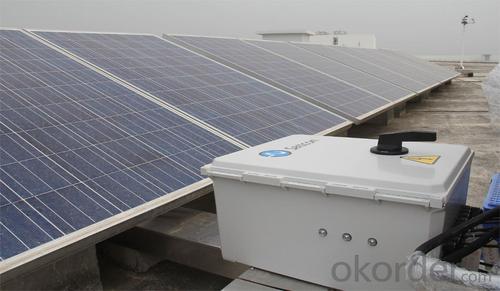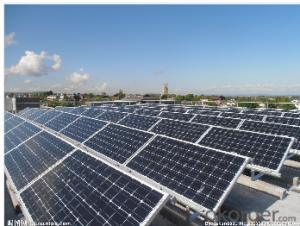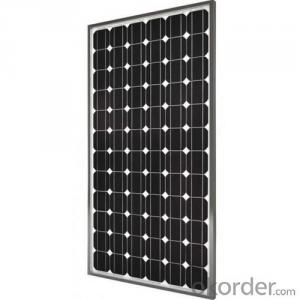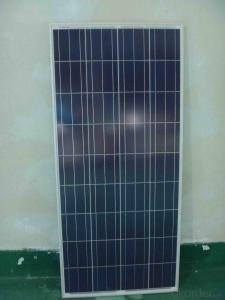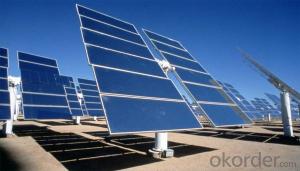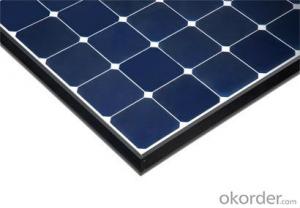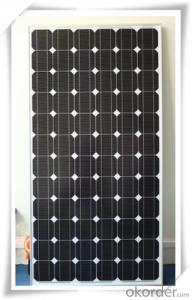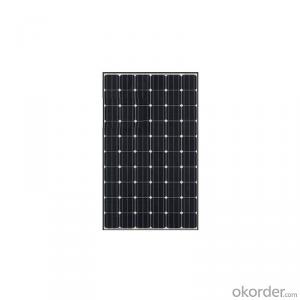160w Mono Solar Panel for Residential Solar System - Solar Panels for Sale New York
- Loading Port:
- Shanghai
- Payment Terms:
- TT OR LC
- Min Order Qty:
- 1000 watt
- Supply Capability:
- 1000000 watt/month
OKorder Service Pledge
OKorder Financial Service
You Might Also Like
Specification
Product Description
Features
High reliability with guaranteed -3% to +5% power output tolerance, ensuring return on investment
High conversion efficiency based on leading innovative photovoltaic technologies
Withstands high wind-pressure and snow load, and extreme temperature variations
Attractive appearance
Unique frame design, high mechanical strength, and easy Installation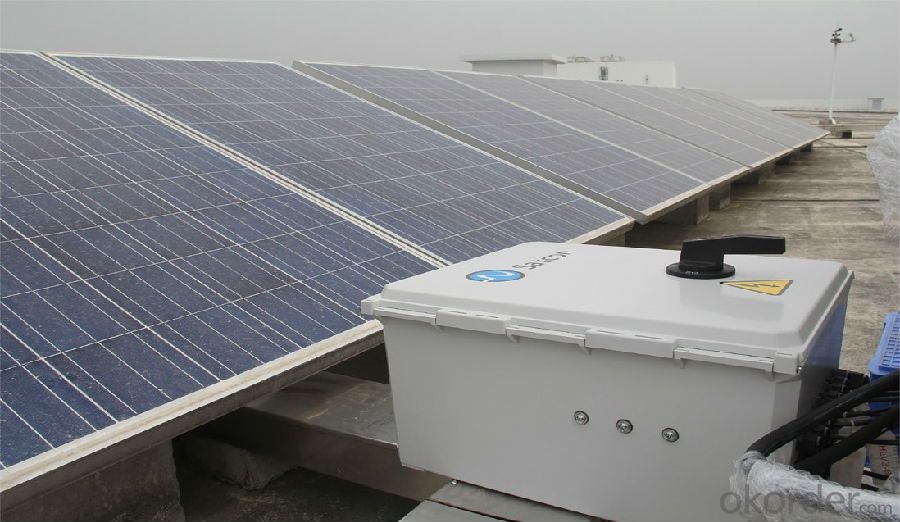 Efficiency
Efficiency
Low voltage-temperature coefficient allows higher power output at high-temperature condition
High efficient, high reliable solar cells ensure our product output stability
Materials
Glass
1.High light transmission no less than 91.6%
2.Excellent mechanical loading performance (5400 PA)
EVA
1.High light transmission
2.High GEL and peeling strength guarantying strong encapsulation
3.Good ultraviolet aging resistance
4.Excellent oxidation resistance
5.TUV certified
Cell
1.Excellent efficiency and long term reliability
2.Good performance under high temperature and low irradiance conditions
3.100% In-line Electroluminescence (EL) tested
4.Positive tolerance for each panel
5.Cell efficiency filling by 0.2 percentage
6.TUV certified
Back sheet
1.TPT based encapsulation and protection
2.Good aging resistance
3.Excellent adhesion and ultraviolet stability
4.TUV certified
Frame
1.Anodized/ Electrophoretic aluminium means durable protection from environment
2.Unique design profile ensuring strong mechanical loading performance
3.Silver/ Black color available
Junction box
1.Climate membrance:Excellent heat dissipation, prevent steam coming from outside and corrosion of diode by inside steam on the condition of big difference in temperature
2.IP65 protection
3.TUV certified
Connector
1.MC4 compatible/ IP65 or MC4 original/ IP67
Packaging & Delivery
1.Packaging Detail:2PCS/CARTON;504PCS/40';520PCS/40'H
2.Delivery Detail:10-15 days after receiving deposit
Quality and Safety
1.Rigorous quality control meeting the highest international standards
2.25-year power output transferable warranty
3.Have TUV, IEC, CE, ISO9001/14004 and RoHS certificates
Main Export Markets:
1.Central/South America
2.Eastern Europe
3.MID East/Africa
4.North America
5.Western Europe
| Electrical Characteristics | |
| Cells size (mm): | 156*156 |
| Cells per module: | 36pcs |
| Module size (mm): | 670*1475*35 |
| Power tolerance: | +/-3% |
| Nominal peak power(WP): | 160w |
| Nominal voltage(V): | 17.5 |
| Nominal current (A): | 9.14 |
| NOCT: | 45+/-2degree |
| Voltage temperature coefficient: | -0.33%/degree |
| Current temperature coefficient: | +0.05%/degree |
| Power temperature coefficient: | -0.23%/degree |
| Open circuit voltage (Voc): | 21.6 |
| Short cirsuit current(Isc): | 9.87 |
| Conversion efficiency: | 18.30% |
| Operating temperature: | -40 to+85degree |
| Max system voltage: | 1000V DC |
| Surface Maximum Load Capacity | 60m/s(200kg/sq. m) |
| Cell power | 4.44w |
FAQ:
1.Price per watt?
It depends on the quantity, delivery date and payment terms.
2.Parameter of the module?
We have different series of panels in different output, both c-si and a-si. please take the specification sheet for your reference.
3.Can you provide the peripheral products of the solar panels, such as the battery, controller etc.?
We have two companies(CNBM International & CNBM engineering Co.) with different approaches. We can supply not only the solar module but also Solar Cells, off grid solar system, even service with on grid plant.
4.Warranty policy?
Our product performance guarantees for 25 years
• 12 years guarantee for workmanship
• Timeliness of delivery
• Quality Products certified (TÜV, UL, CE, ISO)
5.Lead time?
In 3 days after purchasing, we will arrange the factory delivery ASAP. The specific time of receiving is related to the state and position of customers. Commonly 7 to 10 working days can be served.
- Q: I have a cabin that is way out in the middle of no where, it would cost 000's of dollars to get power to it. If I have a 8,000 BTU air conditioner that runs on 25 volts and 5 amps (or 875 watts)How many solar panels will I need to run this during the day, plus charge the batteries to run it all night? How many batteries would I need
- OK, in addition to the solar panels, you wil need an inverter (DC to AC; 2V t0 20V) capable of delivering 20A continuously and as much as 40A for the compressor starting surge, and a fairly large battery bank capable of delivering something over 2000 watts continuously (losses in the charging and conversion process) as well as the surge. So, if your actual demand is now calculated around 2000 watt/hour, and you need to both run the unit and charge batteries during the daylight hours - and considering that the ideal charging rate for a lead-acid battery is on the order of 0% of its capacity, you will need a huge reserve on the battery section and a huge excess on the solar section to make up for the 5 hours maximum input. So, the average high-quality deep-discharge battery will do about 400Ah @ 2.6V. Which comes to 5040 watts for one hour. For round figures, it will give you 2000 watts for 2.5 hours. You will need a minimum of eight of them just to make your system run for the 9 hours you are anticipating. Given that you do not want to run the batteries to zero each night, a 50% reserve would be a wise investment - comes to now twelve (2) batteries. Now, you will have to make 2000 watts (to run the unit) and also produce and another 8600 (per hour for five hours) watts to charge the batteries for the next night. Again, for round figures, you will need 0,000 watts of solar power, or seventy (70) panels. At ~0 watts/s.f. (00 watts/meter), that comes to about 000 square feet or 00 square meters. Modern non-crystaline panels may reduce this by 20%, or so but no more than that. You will be charging the batteries at roughly 20% of their discharge capacity - which will pretty much cut their service live in half, or so. As the average deep-discharge battery has about an 8-year life span under ideal conditions (and your situation will be far from ideal) you may expect to replace them every four years or so with good care. Much less with no care.
- Q: Can solar panels be used for powering electric lawnmowers or gardening tools?
- Yes, solar panels can be used to power electric lawnmowers or gardening tools. They can be connected to a battery system that stores the solar energy and then powers the electric equipment. This provides a sustainable and eco-friendly alternative to traditional power sources.
- Q: i check the diodes in the backside of solar panels it reads out to be 0.433 each give me the same result but i was amazed when i check out the last two one which on clamp meter screen give me ''0L'' what this means? is that diode have malfunctions??is this reasons that the output of solar has been decreased?
- First of all, make sure that you are taking readings in the dark (with the solar panel indoors and covered). 0.433 is a reasonable forward voltage for a Schottky diode. Ideally, it diode should read open one way (possibly OL for your meter), and 0.4 the other way. If it's reading OL both ways, the diode is bad. You can either unsolder it or cut it out and verify that it is bad.
- Q: Can solar panels be installed on mining or extraction sites?
- Yes, solar panels can be installed on mining or extraction sites. In fact, installing solar panels in these areas can be beneficial as it provides a renewable and sustainable source of energy to power mining operations. Not only does it reduce reliance on fossil fuels, but it also helps offset carbon emissions associated with mining activities. Additionally, solar panels can help lower energy costs and contribute to a more environmentally friendly mining industry.
- Q: How do solar panel power systems work?
- Solar power works by making solar cells of two kinds of glass; one which has been “doped” to have too many electrons, and the other which has been “doped” to have too few electrons. These layers of glass are then glued together with a thin insulation layer in between them. The top layer of glass is the one with too many electrons, the bottom layer of glass has too few electrons, and the insulation allows electrons to pass from the bottom layer to the top layer easily, but not from the top layer to the bottom layer as easily. As photons come flying into this glass sandwich at the speed of light, the photons crash into the electrons in both layers and cause them to start moving. The electrons in the top layer are tightly packed and can’t move much, but the electrons in the bottom layer can move around enough that they end up crossing through the insulation into the top layer. However, because there are already too many electrons in the top layer, the newly arrived electrons have no place to rest. This buildup of electrons creates an “electrical pressure”. Then contacts are glued to the glass top and bottom, and a wire is added to connect the top layer to the bottom, and the electrical pressure which has built up in the top layer now has a way to escape, and the extra electrons which crossed over the bottom to the top can now return to the bottom layer. This flow of electrons from the top layer to the bottom layer is the electricity generated by the solar cell. A solar “panel” is made up of many of these cells wired in series to increase the voltage to make it high enough to do some useful work, such as charging batteries, and many of these panels can be wired together to do such things as supplying power to a building, or even supplying power to the utility grid.
- Q: My home uses an average of 2400 kW per month (28,800 per year.) How much can I expect it to cost to install solar panels of this amount? (It is not my intention to go off of the electric company's grid. I would like to generate what I can / possibly sell back extra power)What quot;hiddencosts are there? What is the average life of them?What is the quot;best(cost effective and green) solution / approach?(BTW.... I am in southern LA if that makes a difference)Best answer will go to clear answer WITH links/resources to back it up!)THANKS A MILLION!!! I hope you have a safe and happy holiday season!!!
- A solar system evolves many more components than just panels, and each with its own level of complexity and expense. Is electricity the only option for your consumption? I thought similarly yrs ago with my system, but now over the years the maintenance of panels, subpanels, charging systems, high effic batteries, etc has now proven to me that I should have ensured all other possible improvements be covered first to lower my overall uses.
- Q: hi so im doing a school project thing and they have a lot of different questions for us that help us decide whether we would rather a city have a nuclear reactor, or solar panel. But i cant seem to get the last 2 questions...help please???so question ........What types of emissions, if any, are produced by each type of generating station? Do these emissions affect human health?question 2.....What are the long term financial costs associated with maintaining each type of generating station?thanks!
- : Mostly produce heat 2: Keep Clean, trim branches, over hanging shrubs, and things like that.
- Q: I have been thinking about getting solar panels for my house. What do you think I should get? Companies? Prices? I also have another question. How much energy can a small solar panel produce?
- A small panel will not produce much power. When people put solar electric panels on their house with the goal of saving money, they generally put up a lot of large panels - 200 or 500 square feet worth. Its hard to save money with just one panel. The only way to get close on how much it will cost and whether that represents a savings is to get out your electric bills for the past year, and call a local solar installer for a quote. The system on our house cost $20,000 and we got back $8,000 in incentives, so $2,000 net. It can save money, but that will be over many, many years.
- Q: Hey was looking at a 5 watt 2 volt solar panel and was wondering if it'd be enough to power a regular light bulb. Also need to power a 5volt 6.5 amp pump for at most a minute at a time. So basically if I had this panel would I be able to plug a lamp into it and have it light for 5+ hours at a time with the possibility of running the pump? If not what size panel would I need?
- NO ! Pump needs 747 watts power. And you need to buy one more expensive DC to AC converter to make it work. Use solar panel at least has 000W output.
- Q: I want to install solar panels in my roof and most installers don't recommend any particular brand. Do you have experience with any particular brand that has worked for you or anybody you know? Does the brand of the panel make a difference?
- Mitsubishi panels have served us well for 3 years so far, no problems. Kyocera had a well-known problem many years ago, but they lived up to the warranty and replaced defective panels. Their current products are considred good. I like the value delivered by Suntech panels. Might be a best buy - shop around. I have not heard about any of the major brands having trouble, lately. If you're intending to connect to the grid, be cautious about used or blemished panels. While they might work fine, they usually are ineligible for rebates.
Send your message to us
160w Mono Solar Panel for Residential Solar System - Solar Panels for Sale New York
- Loading Port:
- Shanghai
- Payment Terms:
- TT OR LC
- Min Order Qty:
- 1000 watt
- Supply Capability:
- 1000000 watt/month
OKorder Service Pledge
OKorder Financial Service
Similar products
Hot products
Hot Searches
Related keywords



